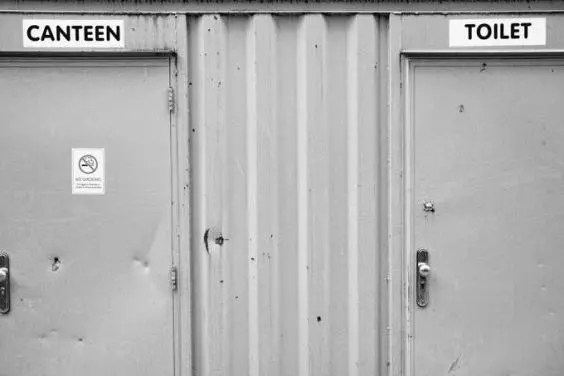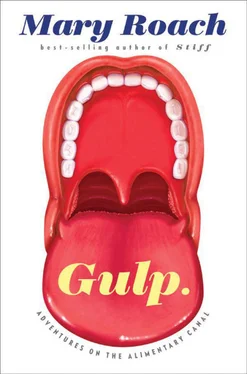You may be wondering why the minds of medicine so assiduously concerned themselves with the matter. Were they drawn to it simply as lecture hall spectacle? Not entirely. The experiments aimed to resolve a lingering medical debate over the value of “feeding per rectum.”
15. Eating Backward
IS THE DIGESTIVE TRACT A TWO-WAY STREET?


AS FAR BACK as ancient Egypt and as recently as 1926, patients unable to keep their food down would be given their food up. The “nutrient enema” was a last resort for people who, the thinking went, would otherwise starve. As unlikely as it may sound, the practice was broadly accepted in the medical community, so much so that ready-made preparations were available for purchase. You would see them advertised in the pages of journals, complete with the occasional customer testimonial (as from the satisfied 1859 patient for whom rectal coffee [104] But not boiling hot coffee. The contemporary fad for coffee enemas has sent more than one person to the emergency room with a partially cooked colon. I first heard about this from a veteran ER nurse. “You have no idea what people will do to themselves,” she wrote in an e-mail. “Forget to remove the potato that you used as a pessary until you noticed a vine sprouting between your legs? Decided to do your own nose job at the bathroom mirror and replace the cartilage with a leftover piece from last night’s chicken dinner? You have no idea.”
and cream “relieved the sense of ‘famishing thirst’ better than any other injection”).
President James Garfield was the poster boy of rectal feeding. In 1881, Garflield’s liver was pierced by an assassin’s bullet and shortly thereafter inoculated with a dose of bacteria from the unwashed fingers and instruments of Dr. D. [105] The D stood for “Doctor.” Garfield’s doctor was Dr. Doctor Willard Bliss. For reasons lost to time, Bliss’s parents named their boy after a New England physician, Dr. Samuel Willard. It would seem they mistook the doctor’s title for his first name, for rather than naming their son Samuel Willard Bliss, as the custom would dictate, they christened him Doctor Willard Bliss. Perhaps to simplify his life, the boy went into medicine—despite a seeming shortage of aptitude and professional ethics. In addition to allegedly hastening Garfield’s death (and then submitting a bill for $25,000—around half a million in today’s currency), Bliss is said to have employed untrained cabinet members’ wives as nurses. Conveniently, no matter what happened, even were he stripped of his medical license, he would always be Doctor Bliss.
W. Bliss. From August 14 to the time of Garfield’s death on September 19, the dwindling, retching head of state, on Bliss’s orders, was fed nothing but nutrient enemas prepared in the dispensary of the United States surgeon general.
Here is the recipe for Assistant U.S. Surgeon General C. H. Crane’s Rectal Beef Extract: “Infuse a third of a pound of fresh beef, finely minced, in 14 ounces of cold soft water, to which a few drops of muriatic acid and a little salt… have been added. After digesting for an hour to an hour and a quarter, strain it through a sieve.” The yolk of an egg was then added, along with 2 drams of Beef Peptonoids and 5 drams of whiskey.
The nice thing about cooking for someone who can’t taste the food is that the same dish can be served over and over without complaint. Or without the usual complaint. A downside to eating rectally is that body heat quickly leads to rot and reek. President Garfield and his nurses endured five days of sulfurous flatus so “annoying and offensive” that egg yolks were stricken from the recipe. Beef blood was likewise to be avoided; one physician lamented that the odor produced by decomposing blood was “so offensive as to pervade the whole house.” Bouillon, another common rectal menu item, also created optimal conditions for bacteria. (Before agar was widely used for laboratory cultures, a medium of choice was beef broth.) The enema-fed rectum was a highly efficient incubator, an in-house petri dish.
What’s worse, proceeding too quickly could trigger the more traditional goal of the enema. (I suppose it wasn’t that far removed from feeding a baby. Though where do you hang the bib?) “I need hardly say,” wrote a learned contributor to the British Medical Journal in 1882, “that the rectum should be empty when a nutrient injection is to be given.” A before-dinner enema of the cleansing variety was recommended.
As a way around the problem, food could be mixed with wax and starch to form a suppository. An additional advantage of this, wrote Bliss in Feeding per Rectum , [106] Why an entire book about rectal alimentation? Because, said Bliss, it is “more interesting than any romance.”
was that patients could manage their own feeding and need not be confined to the hospital. “The convenience of this method is very great,” he enthused. It was the Clif Bar of rectal alimentation. Bliss followed with a caveat: “In some cases, owing to irritability of the rectum, the whole suppository has been returned.” In the history of medicine, has a gentler euphemism ever been coined for the act of excretion? Excuse me, here you go, I’m returning this?
Eventually Heschl and Dawson and the others came along, hosing their cadavers and publishing their papers. The ileocecal valve experiments made it clear: the small bowel—the homeland of nutrient absorption—was, under normal, nonhydraulic circumstances, unreachable via reverse passage. This is why the meat preparations tended to include some minced pancreas. The hope was that the pancreatic enzymes would break down proteins into something more readily absorbed by the colon and rectum.
Did rectal feeding provide nourishment or just hydration? What—and how much— was being absorbed? A round of experiments got under way, and it soon became clear that the colon and rectum were incapable of absorbing large molecules: fats, albumins, proteins, all of it was returned a few days later. Salt and glucose, some short-chain fatty acids, a few vitamins and minerals, these things were retained to a certain extent. And little else. Ninety percent of nutrient absorption takes place in the small intestine. Rectal meals could postpone death, but it was an exaggeration to say they sustain life.
Interestingly, the Vatican proposed a similar experiment in the 1600s. The Church sought an answer to the nagging question “Does rectal consumption of beef broth break one’s Lenten fast?” This was a subject of some controversy within the Church. Pharmacists of the day were turning a brisk business administering bouillon enemas to nuns and other pious, peckish Catholics who found that this helped them make it to lunch. The Vatican rules on fasting define food as “something digestible, received from outside into the mouth and passed by swallowing into the stomach.” By this definition, an enema does not technically break one’s fast. [107] The priestly handbook The Celebration of Mass helpfully enumerates other substances that may enter the digestive tract without technically breaking one’s fast: gargled mouthwash; swallowed pieces of fingernail, hair, and chapped skin from the lips; and “blood that comes from… the gums.”
Enema madness in the convents was forcing the Vatican to reconsider. An experiment was proposed whereby volunteers would be fed strictly by rectum. If they survived, the enema would have to be considered food and therefore banned. If they didn’t, the definition would remain as is, and some vigorous penance would be in order. In the end, nobody volunteered and the nuns continued, wrote Italian medical historian A. Rabino, to “welcome the clysters in their cells with tranquil conscience.”
Читать дальше














